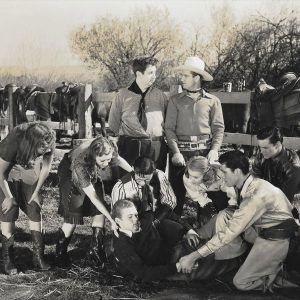calsfoundation@cals.org
Dixon Howard (Dick) Hogan (1917–1995)
Dick Hogan was a singer and actor whose entertainment career began in the mid-1930s and ended in the late 1940s. He is remembered mainly for his many film appearances during the 1940s, which included notable supporting roles in several popular war-themed motion pictures.
Dixon Howard Hogan was born in Little Rock (Pulaski County) on November 27, 1917. His parents were Dixon Henry Hogan and Agnes Smith Hogan, and he had an older sister, Margaret. His father and an uncle, Ben M. Hogan, owned construction businesses that contracted for numerous Arkansas road construction projects. After graduating from Little Rock’s Central High School, he attended the University of Arkansas (UA) in Fayetteville (Washington County) in 1934–35 before moving to California to further his singing career. On December 27, 1939, he married Frances Ellen Hayes of Little Rock, who was described in a contemporaneous news release as his high school sweetheart. The wedding ceremony was held at Winfield Methodist Church in Little Rock.
Before working in motion pictures, Hogan was a night club and big band singer, including a short stint with the Glenn Miller Orchestra. Hogan’s first minor supporting roles were in three films released in 1937: Blazing Barriers, Annapolis Salute, and Saturday’s Heroes. From 1937 through 1948, he appeared in forty feature films, often in uncredited roles. Some of his more prominent performances were in director John Ford’s Submarine Patrol (1938); a Gene Autry western, Rancho Grande (1940); another western, Prairie Law (1940); and three movies released in 1943: Cinderella Swings It, Action in the North Atlantic, and So Proudly We Hail!.
On October 30, 1942, during World War II, Hogan enlisted in the U.S. Army Air Corps. In 1943, he was a cast member in the Broadway production and national touring company of Winged Victory, a critically acclaimed play about the United States’ air forces. Many cast members were, like Hogan, professional actors serving in the military. He also appeared in the film version released at the end of 1944.
Winged Victory was Hogan’s last film performance during his military service. He resumed his career in Blaze of Noon (1947). He appeared in only three more feature films, plus the Alcoa-sponsored short Curiosity Shop: The Story of the Aluminum Research Laboratory (1948), directed by Arkansas native Jean Yarbrough. His final film was Alfred Hitchcock’s classic Rope (1948), based loosely on the infamous 1924 Leopold and Loeb case, in which he played the brief but pivotal role of murder victim David Kentley.
Hogan returned to the stage for his final performance as an actor in a supporting role in the theatrical production Time for Elizabeth, a comedy written by Norman Krasna and Groucho Marx. Hogan received some good reviews for his part, but the play was unsuccessful, opening on Broadway on September 27, 1948, and closing its week-long run on October 2.
Hogan retired from acting and returned to Little Rock, where he worked as an insurance agent. He died there of a heart attack on August 18, 1995. His remains are interred at Little Rock National Cemetery.
For additional information:
Cochran, Robert, and Suzanne McCray. Lights! Camera! Arkansas!: From Broncho Billy to Billy Bob Thornton. Fayetteville: University of Arkansas Press, 2015.
“Dick Hogan.” Internet Movie Database. https://www.imdb.com/name/nm0389516/ (accessed January 29, 2020).
“Dick Hogan; Big Band Singer, Movie Actor.” Los Angeles Times, August 26, 1995. https://www.latimes.com/archives/la-xpm-1995-08-26-mn-39162-story.html (accessed January 29, 2020).
“Time for Elizabeth.” Internet Broadway Database. https://www.ibdb.com/broadway-production/time-for-elizabeth-2023 (accessed January 29, 2020).
Greg A. Phelps
Lindsey Wilson College


 Dick Hogan in Rancho Grande
Dick Hogan in Rancho Grande 



Comments
No comments on this entry yet.